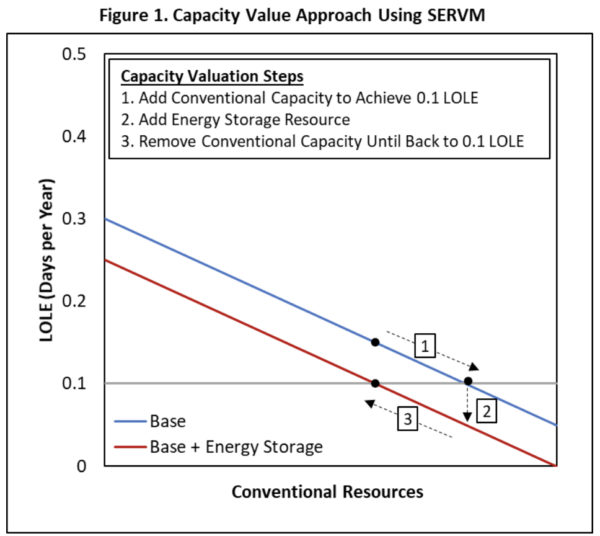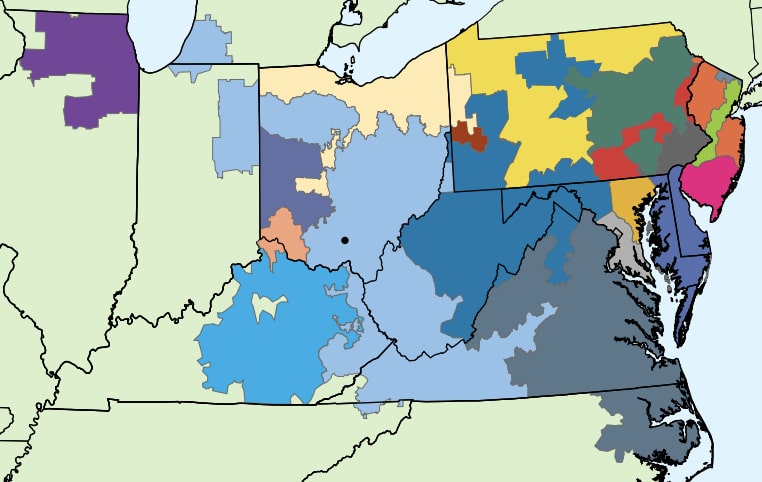When the PJM Interconnection* proposed that energy storage needed 10 hours duration to qualify for capacity payments, that seemed to make no sense.
No other grid operator had proposed such a requirement—essentially disqualifying battery storage—in its plan for complying with an order from the Federal Energy Regulatory Commission to allow energy storage to participate in all markets where it is technically capable of doing so (including capacity markets).
Now we have an analysis that debunks PJM’s proposal.
Storage with 4-hour duration can provide up to 4,000 MW of capacity of “equivalent reliability value” to that supplied by conventional power plants in PJM, according to a study by Astrapé Consulting.
Astrapé used the SERVM model for its analysis, a model it has used for similar evaluations it has performed for other regional grid systems such as ERCOT, MISO, and SPP.
Astrapé’s report concluded:
A 4-hour duration requirement would correctly represent the capacity value of storage under current market conditions and would remain accurate until the amount of installed storage in PJM increases by two orders of magnitude.”
The “two orders of magnitude” refers to the 40 MW of 4-hour non-hydro storage that Astrapé determined is currently operating in the PJM region, compared to the 4,000 MW potential.
The capacity payments at issue are intended to ensure that adequate reserve capacity is available to meet demand at occasional times of extreme demand, such as extremely hot or cold days.
But when storage is excluded from the capacity market, that causes the market-clearing price for capacity to be higher, increasing customers’ electric bills. Meanwhile, lower compensation for storage can limit otherwise cost-effective deployments of solar and wind power, which pair well with storage.
In its analysis, Astrapé followed an elegant approach illustrated in Figure 1. In step 1 as shown, Astrapé modeled the addition of conventional capacity to reduce the “loss of load expectation” (LOLE) to 0.1, a “generally accepted reliability criterion” that “represents a single day of firm load shed in a 10-year period.” In step 2, Astrapé modeled the addition of energy storage, reducing LOLE below 0.1. In step 3, Astrapé modeled the removal of conventional capacity until LOLE was again 0.1. This yielded a ratio of storage capacity added to conventional capacity removed.

Astrapé continued with iterations of this approach, ultimately discovering that 4,000 MW of 4-hour storage could displace 3,996 MW of conventional capacity, for a capacity value of 99.90 percent.
Astrapé reported that with energy storage deployments up to 4,000 MW, “4 hours of duration allows those resources to provide full capacity value relative to a resource without duration limits.” With energy storage deployments up to 8,000 MW, Astrapé found that 6 hours of duration allows those resources to provide full capacity value.
“Within these limits, storage can replace traditional generation MW-for-MW with no reduction in system reliability,” Astrapé explained.
Both Astrapé’s analytical process and the SERVM model “have been vetted by state regulators for over three decades,” Astrapé noted.
A separate study by the U.S. Energy Storage Association (ESA)—one of two sponsors of the Astrapé study—found that many conventional power plants “failed in actual operations to meet the 10-hour requirement that PJM proposes for storage,” based on its analysis of data from power plant continuous emissions monitoring systems, collected by the U.S. Environmental Protection Agency.
ESA found that during the days of highest demand in PJM—”ostensibly the basis for PJM’s 10-hour requirement”—18,000 MW to 36,000 MW of power plant capacity “either did not run or generated output that a 4-hour storage unit could provide,” as shown in Figure 4 below.

The Federal Energy Regulatory Commission (FERC) order that prompted PJM’s proposed compliance plan is known as FERC Order 841.
ESA notes that now “it is up to FERC to adjudicate the present dispute and determine the extent to which storage will be allowed to offer its full contributions and compete with fuel-based power plants to provide capacity service in PJM.”
The Astrapé study was sponsored by the U.S. Energy Storage Association and the Natural Resources Defense Council. A helpful primer on both capacity payments and the Astrapé study was prepared by the Energy Storage Association.
Editor’s note: PJM is the regional transmission organization serving an area from Chicago to New Jersey.
This content is protected by copyright and may not be reused. If you want to cooperate with us and would like to reuse some of our content, please contact: editors@pv-magazine.com.








By submitting this form you agree to pv magazine using your data for the purposes of publishing your comment.
Your personal data will only be disclosed or otherwise transmitted to third parties for the purposes of spam filtering or if this is necessary for technical maintenance of the website. Any other transfer to third parties will not take place unless this is justified on the basis of applicable data protection regulations or if pv magazine is legally obliged to do so.
You may revoke this consent at any time with effect for the future, in which case your personal data will be deleted immediately. Otherwise, your data will be deleted if pv magazine has processed your request or the purpose of data storage is fulfilled.
Further information on data privacy can be found in our Data Protection Policy.